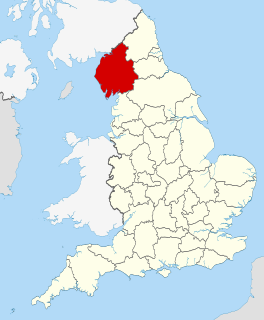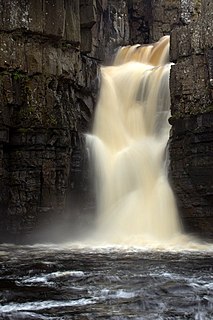Moor House-Upper Teesdale National Nature Reserve covers 7,400 ha of the Pennine moors in the north of England. It straddles Cumbria and County Durham. It was designated a UNESCO biosphere reserve in 1976.

The hectare is an SI accepted metric system unit of area equal to a square with 100-metre sides, or 10,000 m2, and is primarily used in the measurement of land. There are 100 hectares in one square kilometre. An acre is about 0.405 hectare and one hectare contains about 2.47 acres.

Cumbria is a ceremonial and non-metropolitan county in North West England. The county and Cumbria County Council, its local government, came into existence in 1974 after the passage of the Local Government Act 1972. Cumbria's county town is Carlisle, in the north of the county, and the only other major urban area is Barrow-in-Furness on the southwestern tip of the county.

County Durham is a county in North East England. The county town is Durham, a cathedral city. The largest settlement is Darlington, closely followed by Hartlepool and Stockton-on-Tees. It borders Tyne and Wear to the north east, Northumberland to the north, Cumbria to the west and North Yorkshire to the south. The county's historic boundaries stretch between the rivers Tyne and Tees, thus including places such as Gateshead, Jarrow, South Shields and Sunderland.
Contents
The Moor House area was in the first group of National Nature Reserves (NNRs) created in England when it was designated in 1952. Upper Teesdale was a separate nature reserve until the end of the twentieth century. The combined reserve is England's highest and largest NNR. [1] Great Dun Fell is the highest point. The Pennine Way passes through both “halves” of the reserve.

Upper Teesdale is a Site of Special Scientific Interest (SSSI) in the Teesdale district of west County Durham, England. It encompasses an extensive upland area that includes the headwaters of the River Tees and the surrounding catchment area upstream of the village of Langdon Beck.

At a height of 848 metres, Great Dun Fell is the second-highest mountain in England's Pennines, lying two miles south along the watershed from Cross Fell, its higher neighbour. Together with its smaller twin, Little Dun Fell, which reaches 842 metres, it forms a stepping-stone for the Pennine Way on its long climb up from Dufton.

The Pennine Way is a National Trail in England, with a small section in Scotland. The trail runs 267 miles (429 km) from Edale, in the northern Derbyshire Peak District, north through the Yorkshire Dales and the Northumberland National Park and ends at Kirk Yetholm, just inside the Scottish border. The path runs along the Pennine hills, sometimes described as the "backbone of England". Although not the United Kingdom's longest National Trail, it is according to the Ramblers' Association "one of Britain's best known and toughest".











